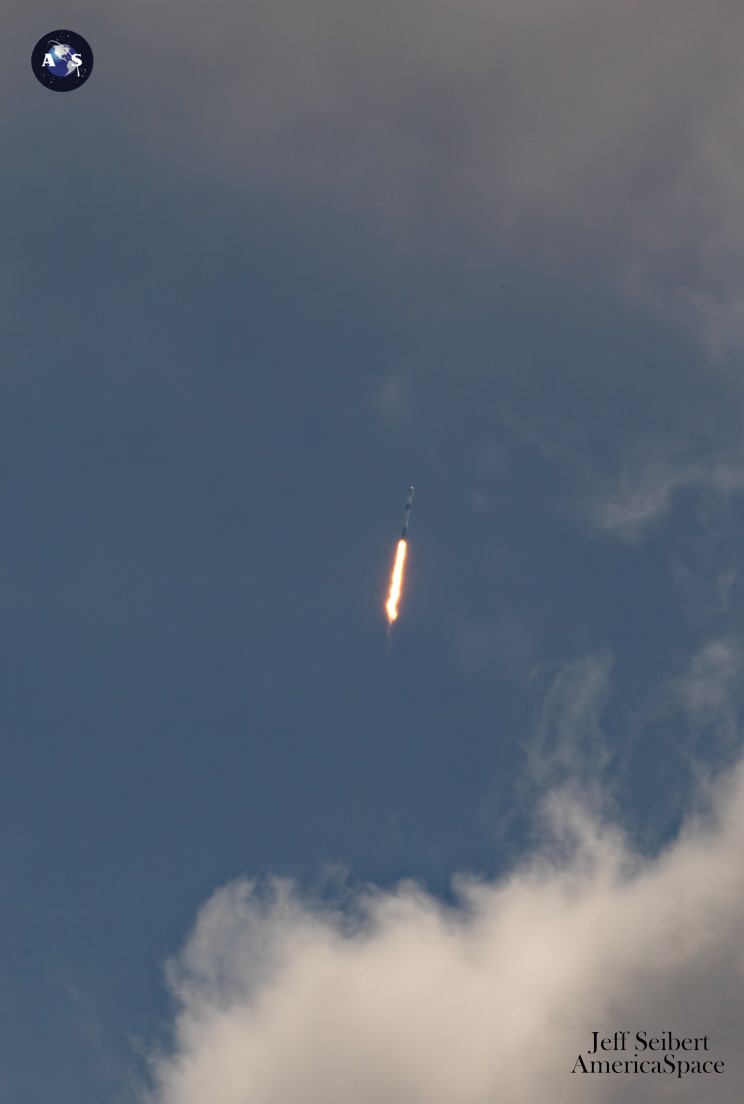
SpaceX closed out an impressive nine-launch month earlier today by flying its first-ever Falcon 9 on a “Leap Day”, 29 February. Following hard on the heels of eight earlier missions in the past four weeks—including a NASA-led ocean/climate-monitoring mission, an Indonesian geostationary communications satellite, a highly classified group of payloads for the U.S. Space Force, Missile Defense Agency (MDA) and Space Development Agency (SDA) and Intuitive Machines’ high-profile IM-1 voyage to the Moon’s South Pole under the Commercial Lunar Payload Services (CLPS) contract—a many-times-used Falcon 9 roared uphill from Space Launch Complex (SLC)-40 at Florida’s Cape Canaveral Space Force Station at 10:30 p.m. EST Thursday, laden with a 23-strong batch of Starlink low-orbiting internet communications satellites.

Following Wednesday’s decision to postpone the launch of Dragon Endeavour and her Crew-8 quartet of NASA astronauts Matt Dominick, Mike Barratt and Jeanette Epps, together with Russian cosmonaut Aleksandr Grebenkin to no earlier than 11:16 p.m. EST Saturday, SpaceX elected to squeeze a ninth Falcon 9 mission into February’s final day, flown out of Space Launch Complex (SLC)-40 at Florida’s Cape Canaveral Space Force Station using the 11-times-flown B1076 booster. It marked the first-ever U.S. orbital launch on a Leap Day, although the crew of shuttle Columbia observed the quadrennial day during their 16-day STS-75 mission in 1996 and at least one U.S. astronaut have been aboard the International Space Station (ISS) for each Leap Day since 2004.
Today’s mission firmed up yesterday with the appearance of an associated weather forecast update, via the 45th Weather Squadron at Patrick Space Force Base, and an announcement late Wednesday from SpaceX. In earlier comments provided by Commercial Crew Program Manager Steve Stich, NASA does not permit a Falcon 9 launch within 48 hours of a Crew Dragon flight, due to insufficient time for data review.

However, citing a steadily deteriorating weather picture SpaceX and NASA announced late Wednesday that they would forego the opening pair of launch attempts for Crew-8—both “instantaneous”, the first timed for 12:04 a.m. EST Friday, the second almost 24 hours later at 11:41 p.m. EST Friday—and aim instead for the third opportunity at 11:16 p.m. EST Saturday. It was noted that both opening launch tries had been called off in response to poor predicted weather across Dragon Endeavour’s flight path in the event that a launch contingency should force an aborted landing.
“High wind and waves along the eastern seaboard have been observed and are forecast to continue through Saturday morning,” NASA noted late Wednesday. “In the unlikely case of an abort during launch or the flight of Dragon, the wind and wave conditions must be within acceptable conditions for the safe recovery of the crew and spacecraft.”

As such, Thursday’s Starlink mission by B1076 closed out February on nine Falcon 9 flights, with weather conditions hovering around 85-percent-favorable, tempered by a slight chance of violating the Cumulus Cloud Rule and Liftoff Winds Rule. However, the outlook for the backup opportunity at 10:04 a.m. EST Friday was expected to decline sharply to only 65 percent favorability.
“Cloud cover will increase as a weak boundary approaches Central Florida tomorrow morning,” the 45th noted of Thursday’s forecast. “A narrow band of light showers will form along the boundary, but any showers that develop will likely be too shallow to cause a weather violation due to very dry air in the mid-levels.”

A slip to Friday morning, however, was expected to produce a far murkier picture. “Conditions become more unfavorable for the backup window on Friday,” it was continued, “as the cirrostratus layer thickens and decreases in altitude.” The result would be a risk of thick clouds, as well as Atlantic low-topped showers.
Today’s mission targeted a two-hour “window” from 10:30 a.m. EST through 12:30 a.m. EST and marked the second outing by B1076 this year and her 11th flight overall. B1076’s career began in November 2022, when she lofted the CRS-26 Cargo Dragon for a six-week berth at the International Space Station (ISS).

She flew an additional eight times last year, heaving 40 broadband satellites uphill for London, England’s OneWeb in the second week of January 2023, followed by the heavyweight Intelsat 40e geostationary communications satellite—co-manifested with NASA’s Tropospheric Emissions: Monitoring of Pollution (TEMPO) payload—in early April, five batches of Starlinks in February, May, July, September and October and a pair of O3b mPOWER communications satellites in November. Her 2024 campaign began with last month’s launch of the Swedish Ovzon-3 geostationary broadband satellite.
Aboard B1076 was a 23-strong Starlink “V2 Mini” payload stack, weighing an estimated 40,600 pounds (18,400 kilograms) and brought to almost 270 the total number of these flat-packed, low-orbiting internet communications satellites inserted into space so far this year and over 5,900 lofted by more than 140 Falcon 9 missions since May 2019. Deployment of the satellites occurred 65 minutes into today’s flight.

As a network, Starlink enables high-speed and low-latency internet provision to over 70 sovereign nations and international markets in North and South America, Europe, Asia, Oceania and Africa. Landlocked Eswatini—formerly Swaziland—in southern Africa and Honduras and Paraguay joined Starlink in December.
The downsized V2 Mini satellites, first flown last February, boast three to four times greater “usable” bandwidth than earlier Starlink iterations. “V2 Minis include key technologies—such as more powerful phased-array antennas and the use of E-Band for backhaul—which will allow Starlink to provide 4x more capacity per satellite than earlier iterations,” SpaceX explained. “Among other enhancements, V2 Minis are equipped with new argon Hall thrusters for on-orbit maneuvering.”

Florida-based intercity operator Brightline adopted Starlink on its trains in 2023, the first passenger rail service in the world to do so. Additionally, El Salvador’s Ministry of Education has begun integrating Starlink capability into its schools to help close the digital divide between urban and remote rural communities and 50 Rwandan schools are now connected via Starlink’s high-speed internet service.
And last month, SpaceX lofted its first six “Direct-to-Cell” Starlinks, which permit mobile network providers to offer “seamless global access to texting, calling and browsing”, whether “on land, lakes or coastal waters”, without the need to change hardware or firmware. Within six days of that first launch, SpaceX engineers sent and received their first text messages via Direct-to-Cell.

In readiness for tonight’s launch, the Autonomous Spaceport Drone Ship (ASDS), “Just Read the Instructions”, put to sea out of Port Canaveral last Sunday, bound for a recovery position about 390 miles (630 kilometers) offshore in the Atlantic Ocean. This was be JRTI’s second deployment in 2024: having taken center-stage during last December’s premature loss of B1058—the one-time ride of Demo-2 astronauts Doug Hurley and Bob Behnken—she was returned to dry dock for a month of repair and refurbishment, only re-entering operational service last week to recover the 17-times-flown B1067 booster after a successful mission to launch Indonesia’s Merah Putih-2 geostationary communications satellite.






One Comment
Leave a ReplyOne Ping
Pingback:SpaceX Targets Three Back-to-Back Falcon 9 Launches Tonight - AmericaSpace